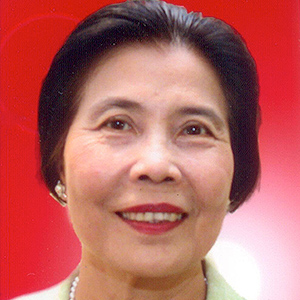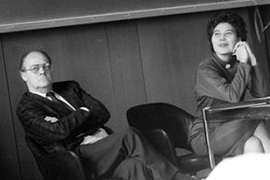
BORN
1936
INDUCTED
2014
CATEGORY
Science / Technology

THE HONOURED INDUCTEES TO THE SINGAPORE WOMEN’S HALL OF FAME
Lam Lay Yong
Award-winning authority on the history of Chinese mathematics
Internationally renowned for her research into the history of Chinese mathematics, Lam Lay Yong is the first woman, and the first person from Asia, to have won the prestigious Kenneth O. May prize for her contribution to mathematics. After 30 years of research, she laid to rest the long held belief that the Arabs and Indians invented the numeral system used today. She offered evidence that it was the Chinese who discovered it, using simple bamboo rods.
The granddaughter of Tan Kah Kee and niece of Lee Kong Chian, both prominent Chinese businessmen and philanthropists, Lay Yong graduated from the National University of Singapore (NUS) with First Class Honours in Mathematics in 1957.
She was then awarded a Queen’s scholarship to study at Cambridge University, after which she returned to Singapore where she began lecturing at her alma mater in 1960. In 1966 Lay Yong completed her PhD at NUS, and she became a full professor in 1988.
Over the years, Lay Yong has written extensively about the history of Chinese mathematics. In so doing, she has brought the many accomplishments of Chinese mathematicians to the attention of global audiences, especially those who do not read or speak Chinese.
For this work, in 2001, Lay Yong was awarded the Kenneth O. May medal, the highest honour given by the International Commission on the History of Mathematics (ICHM), and bestowed only once every four years.
One of her most remarkable discoveries concerns the development of the numeral system used today. Lay Yong says it was actually invented by the Chinese (not the Indians and the Arabs as commonly believed), who were adding, subtracting, multiplying and dividing at least 1,000 years before anyone else, using bamboo rods. In fact, Lay Yong says the Arabs and the Indians only came up with the written symbols for the numeral system.
Between 1974 and 1990 Lay Yong also served the ICHM as associate editor of Historia Mathematica. She is a member of the Académie Internationale d’Histoire des Sciences, and past President of the Singapore Mathematical Society.
Lay Yong retired from NUS in 1996, after having worked at the Department of Mathematics for 35 years. In 2005 Lay Yong also won the Outstanding Science Alumni Award from NUS. One of her most notable books, Fleeting Footsteps: Tracing the Conception of Arithmetic and Algebra in Ancient China, was published in 2004.

Lam Lay Yong
Award-winning authority on the history of Chinese mathematics
BORN 1936 INDUCTED 2014
CATEGORY Sports
Internationally renowned for her research into the history of Chinese mathematics, Lam Lay Yong is the first woman, and the first person from Asia, to have won the prestigious Kenneth O. May prize for her contribution to mathematics. After 30 years of research, she laid to rest the long held belief that the Arabs and Indians invented the numeral system used today. She offered evidence that it was the Chinese who discovered it, using simple bamboo rods.
The granddaughter of Tan Kah Kee and niece of Lee Kong Chian, both prominent Chinese businessmen and philanthropists, Lay Yong graduated from the National University of Singapore (NUS) with First Class Honours in Mathematics in 1957.
She was then awarded a Queen’s scholarship to study at Cambridge University, after which she returned to Singapore where she began lecturing at her alma mater in 1960. In 1966 Lay Yong completed her PhD at NUS, and she became a full professor in 1988.
Over the years, Lay Yong has written extensively about the history of Chinese mathematics. In so doing, she has brought the many accomplishments of Chinese mathematicians to the attention of global audiences, especially those who do not read or speak Chinese.
For this work, in 2001, Lay Yong was awarded the Kenneth O. May medal, the highest honour given by the International Commission on the History of Mathematics (ICHM), and bestowed only once every four years.
One of her most remarkable discoveries concerns the development of the numeral system used today. Lay Yong says it was actually invented by the Chinese (not the Indians and the Arabs as commonly believed), who were adding, subtracting, multiplying and dividing at least 1,000 years before anyone else, using bamboo rods. In fact, Lay Yong says the Arabs and the Indians only came up with the written symbols for the numeral system.
Between 1974 and 1990 Lay Yong also served the ICHM as associate editor of Historia Mathematica. She is a member of the Académie Internationale d’Histoire des Sciences, and past President of the Singapore Mathematical Society.
Lay Yong retired from NUS in 1996, after having worked at the Department of Mathematics for 35 years. In 2005 Lay Yong also won the Outstanding Science Alumni Award from NUS. One of her most notable books, Fleeting Footsteps: Tracing the Conception of Arithmetic and Algebra in Ancient China, was published in 2004.
“Academic papers on the history of Chinese mathematics are not easy to read. Sometimes it does take someone close to a genius to grasp the texts of the publications and to condense them into one chapter or even one paragraph. Whether it’s writing a paper or a book, I always believe that the standards of writing should be maintained at as high a level as possible, even at the sacrifice of slow output.”
Gallery photo(s):
Courtesy of Oberwolfach Photo Collection
Profile last updated: 11th March 2021

